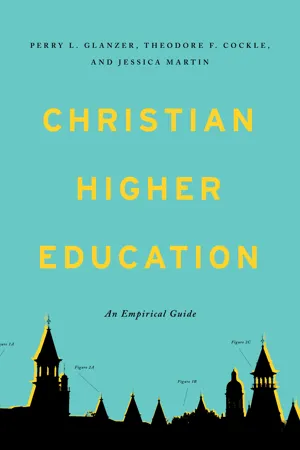
Christian Higher Education
An Empirical Guide
- 176 pages
- English
- ePUB (mobile friendly)
- Available on iOS & Android
About This Book
Utilizing a common set of objective institutional markers as a compass, this book guides readers through the terrain of various Christian institutions. The Christian higher education landscape confuses many people. Future students, parents, staff, and even faculty often do not understand the important subtleties and nuances. They need a guide that empirically explores the ways Christian universities operationalize their Christian identity. This book will guide them through the field of Christian higher education and introduce our Operationalizing Christian Identity Guide (OCIG), which identifies the major ways Christian colleges and universities use their Christian identity to make mission, marketing, membership, curriculum, cocurricular, and other decisions (an online spreadsheet of OCIG scores for all the Christian colleges and universities in North America updated in real-time will be available to readers). These markers are identifiable by anyone, no matter their religious or nonreligious background.The OCIG is then employed to provide readers a tour of Protestant, historically Black, Catholic, evangelical/multidenominational, and Eastern Orthodox institutions in the United States and Canada. Parents, students, staff, and faculty will be equipped to engage Christian higher education with a clearer understanding of these key elements and their importance to the mission and purposes of individual institutions and Christian higher education at large.
Frequently asked questions
Information
Table of contents
- Cover Page
- Title Page
- Copyright Page
- Contents
- Introduction: Confusion about “Christian” Universities
- 1 What Makes a University Christian?
- 2 Mainline Protestant Colleges and Universities
- 3 Historically Black Colleges and Universities (HBCUs)
- 4 Catholic Colleges and Universities
- 5 Evangelical Colleges and Universities in Multidenominational Coalitions
- 6 Independent Low Church Protestant Colleges and Universities
- 7 The One Eastern Orthodox College
- 8 Evaluating the Diversity of Christian Higher Education in the United States
- 9 A New Vision for US Christian Higher Education: Centers for Christian Thought
- 10 Canadian Christian Colleges and Universities
- Conclusion: Using the Results of Our Guide: Messages for Parents, Students, Faculty, Staff, Administrators, and Boards
- Acknowledgments
- Appendix
- Notes